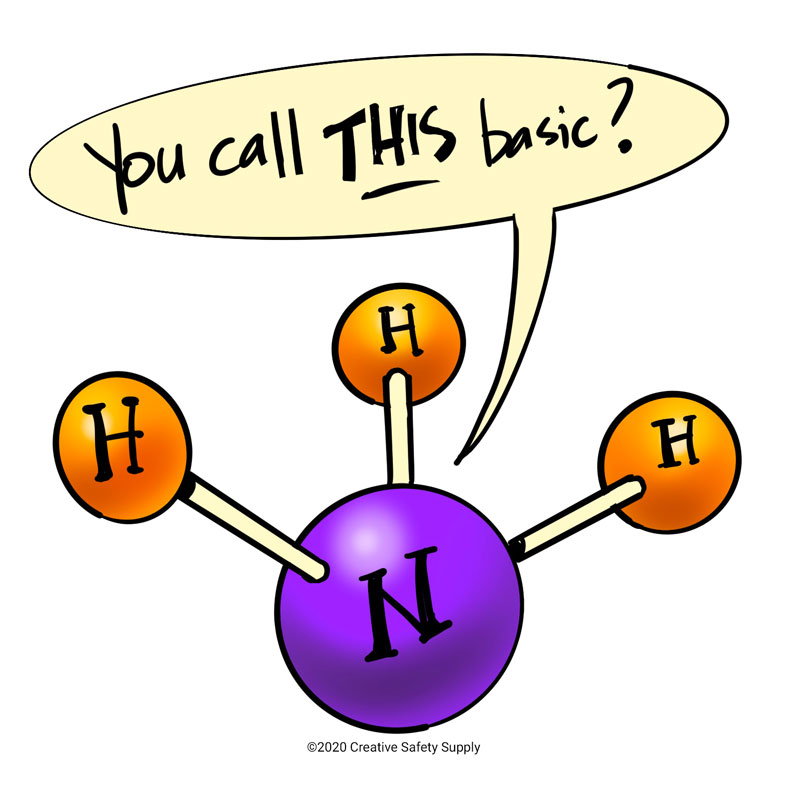
In chemistry, a base refers to any molecule that accepts a proton, while the definition of an acid is any molecule that releases a proton. For this reason, ammonia is considered basic because its nitrogen atom has an electron pair that readily accepts a proton. However, ammonia is classified as a weak base which is a chemical compound that doesn’t completely break apart into ions in an aqueous solution. When molecules break apart into ions the process is called dissociation. This forms a different chemical structure to become either a weak base or a strong acid and vice versa.

Ammonia doesn’t contain any hydroxide ions to begin with, but when it’s dissolved in water it acquires hydrogen ions from the water to produce hydroxide as well as ammonium ions. However, ammonia doesn’t fully convert into hydroxide and ammonium ions in a solution, which is why it is considered a weak base. When it does break apart, it turns into positively charged ammonium ions (NH4+) and negatively charged hydroxide (OH-) ions, but some of the ammonia molecules are still bound together. Because of the fact that not all the molecules were broken apart, the dissociation is considered to be incomplete as only a very minuscule percentage has actually produced hydroxide ions from the ammonia molecules.
Now, when bases or acids are classified as strong or weak, this classification is only meaningful in regard to how concentrations of a given chemical’s reaction is determined. It does not describe how reactive, oxidizing, or caustic their properties are. Strong bases can be just as caustic and dangerous as strong acids. Take anhydrous ammonia as an example: it has a pH level of about 11.6 yet it still gives people chemical burns and causes severe irritation to the mucous membranes, skin, and eyes, just like how hydrochloric acid (pH of 0) exposure is corrosive to those same areas.
Additional Ammonia facts:
- Ammonia is a weak base because its nitrogen atom has an electron pair that readily accepts a proton. Also, when dissolved in water, ammonia acquires hydrogen ions from water to produce hydroxide and ammonium ions. It is the production of these hydroxide ions that imparts ammonia its characteristic basicity. Source: https://www.scienceabc.com/pure-sciences/ammonia-acid-base.html
- The aqueous solution of ammonia is basic. The maximum concentration of ammonia in water (a saturated solution) has a density of 0.880 g/cm 3 and is often known as ‘.880 ammonia’. Source: https://en.wikipedia.org/wiki/Ammonia
- Ammonia is moderately basic; a 1.0 M aqueous solution has a pH of 11.6, and if a strong acid is added to such a solution until the solution is neutral (pH = 7), 99.4% of the ammonia molecules are protonated. Source: https://en.wikipedia.org/wiki/Ammonia
- Ammonia can react with acids to form ammonium salts, which are ionic compounds that have the general formula NH 4 X, where X is the anion of the acid. For example, ammonia reacts with hydrochloric acid to form ammonium chloride, a white solid that can be used as a fertilizer. Source: https://chem.libretexts.org/Bookshelves/Inorganic_Chemistry/Map%3A_Inorganic_Chemistry_(Housecroft)/09%3A_Non-aqueous_Media/9.06%3A_Liquid_Ammonia
- Ammonia can also act as a Lewis base, meaning that it can donate an electron pair to a Lewis acid, which is an electron pair acceptor. For example, ammonia can react with boron trifluoride, a Lewis acid, to form a stable adduct, as shown below. Source: https://chem.libretexts.org/Bookshelves/Introductory_Chemistry/Introductory_Chemistry_(CK-12)/21%3A_Acids_and_Bases/21.07%3A_Lewis_Acids_and_Bases
Similar Questions
- What is ammonia made out of?
- Is ammonia safe to use?
- How does anhydrous ammonia work?
- What is anhydrous ammonia?
- What are the dangers of ammonia exposure?
- What is anhydrous ammonia used for?
- Is ammonia flammable?
- What are the limits for exposure to concentrated ammonia?
- How is ammonia used in refrigeration?


